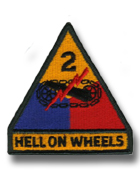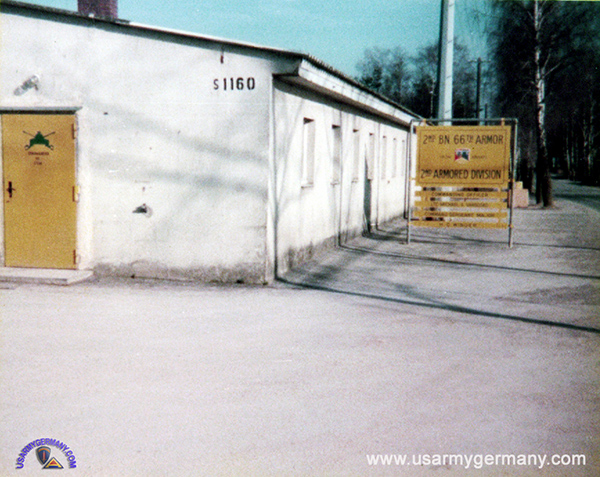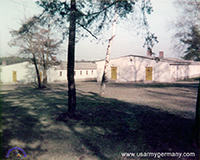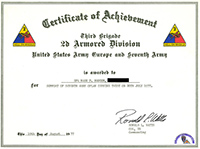| If you do NOT see the Table of Contents frame to the left of this page, then Click here to open 'USArmyGermany' frameset |
||||||||
|
2nd
Armored Division (Forward) |
||||||||
|
|
||||||||
|
||||||||
|
|
||||||||
| 2nd Bn, 66th Armor | ||||||||
| 1977 | ||||||||
| (Source: Email from Mark Magnum) | ||||||||
| My time as part of Brigade ’75 I was assigned to HHC, 2nd Battalion, 66th Armor, 2AD directly out of my AIT training (31V20 – Field Radio Repair) at Ft. Sill. When I arrived, the Battalion was in the middle of their ARTEP training and pushing hard to complete them as they were scheduled to rotate to Germany as part of Brigade’75 in March of 1977. The training had to be completed prior to deploying and we still had an IG inspection to complete in preparation of equipment turnover to the incoming unit. We were going to replace 1/67 Armor. While in Grafenwoehr, the HHC ‘commo’ personnel were assigned to support the CSC (Combat Support Company) Company with their task of border duty along the Czechoslovakian border near Hof, Germany. We would set up large antenna arrays about half way between the Battalion headquarters in Graf and the CSC Company headquarters to re-transmit radio traffic. We made numerous trips to the border in support of the Battalion and Company. The highlight of the tour was a special operation called, Operation Cervine Twist (see attached certificate). What was so special about this was the Battalion was to put on a High Power Armor display for a large contingent of Soviet generals. The goal was to show our maneuverability, readiness and fire power to our ‘enemy’. We had two companies of M60 tanks and they performed a live fire demonstration with the generals following down range behind the front line tanks. My part as commo specialist (I was an E4 SPC at the time) was to rig the M113 APC with extra headset ports and speakers so that the entire process could be heard by the personnel riding in the APC’s. We secured open the top hatches of the APC’s and built floor stands that would allow the riders to stand and see, but most importantly, hear the radio broadcasts of the tank commanders as they moved down range with the tanks. We spent a solid two months in preparation and the exercise lasted less than two hours. It was deemed successful and our commanders did personally thank us for all we did. Our battalion commander got large kudo’s for the job well done which gave us a special return flight back to the states at the end of our deployment. We flew commercial in Class B’s from Nurnberg, Germany to Shannon, Ireland to Bangor, Maine then into Fort Hood. The trip to Germany was C-17 in fatigues to Nurnberg, so the return trip was really nice after 6 months away (March 77 – Aug 77). Upon return to Fort Hood, the 2/66th went back to standard Fort Hood Armor Battalion life until we found out that we were to be the unit that would be sent back permanently to Garlstedt. The next year the Battalion was mostly all new troops as most of us moved on to new assignments in different units. I was transferred to HHT, 2nd Squadron, 1st Cavalry, 2nd AD (2/1 Cav). |
||||||||
|
||||||||
| 1981 | ||||||||
| (Source: Email from Victor N. Pitts) | ||||||||
| I was assigned to 2/66 Armor in July 1981. Our CSM was Donald Maddox.
I was the 1SG of the Combat Support Company in the Battalion. I remember well the old Kaserne and the housing as well. My daughter attended the high school there and my sons also attended school there. We lived in the housing provided to us in OlsterHolz-Sharbeck. It was more or less like town houses and just a short drive to the commissary in town. My CSM was married to a German lady Heidi, and she worked at the commisary as a bagger. They also had 2 daughters -- one was Linda but the other I can't recall. I believe they both married German men from around there and one son-in law worked at a near by SAAB dealership. CSM Donald Maddox retired and he and his wife bought a house in to not far from the Bahn Hof, and he also took a job at the SAAB dealership. this all took place around 1982-83. The Maddox family was the primary care takers of AppleKorn, the Mascot. He was a very nice little pony and everyone loved him. He had his own stable right near the Bde. Hqs. It was mentioned that the 2/66 received the M1 tanks in 1987, but they actually got them in 83-84 time frame because they used them in the old Canadian Cup Shoot Out. In 1983, I left 2/66, and became the Installation Coorinator and was resonsible for the Kaserne and the housing. I also had to put together a new Close Out Plan to use if war broke out and had to send all dependents back to the states, and turn the kaserne over to the Germans. We used to have some good times in the Club and everyone got along good together. My oldest son was one of the kids to help paint a murel on the hall wall of the high school. I will stop now I hope you can use some of this information, I know it brought back many memories for me. I remembered one more thing: in 1982, our A Co. was the first COHORT Company and they were started out from basic, AIT, and moved to 2/66. The first sergeant was Jake Fryer (E7 Promoable) and he took them from the basic all the way. Our C Co. was the first to draw the M1 tanks and start training on them. |
||||||||
|
|
||||||||
|
Related Links: |
||||||||



